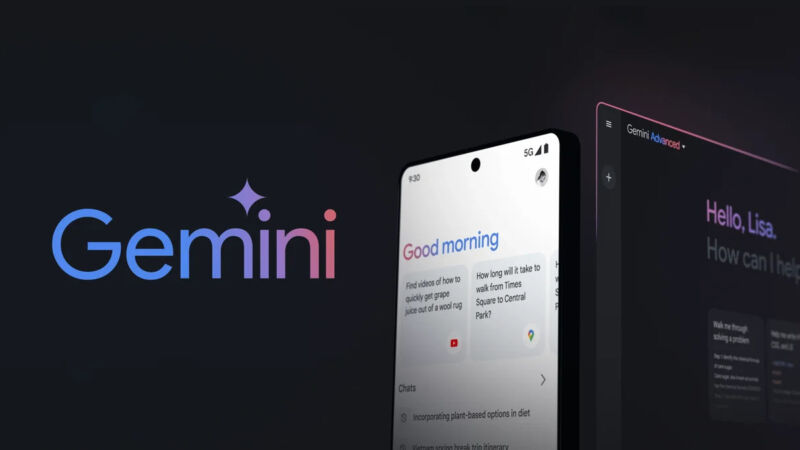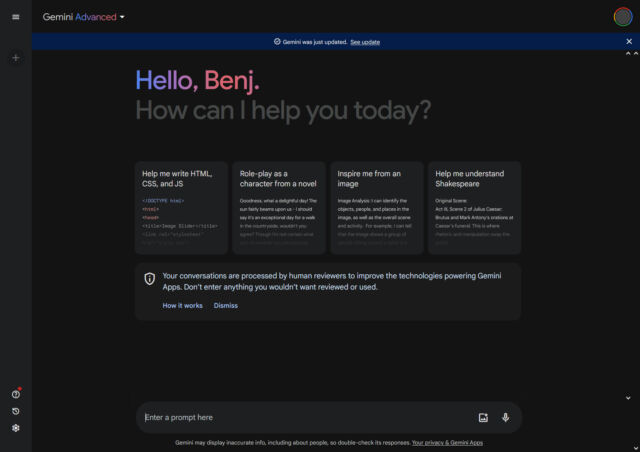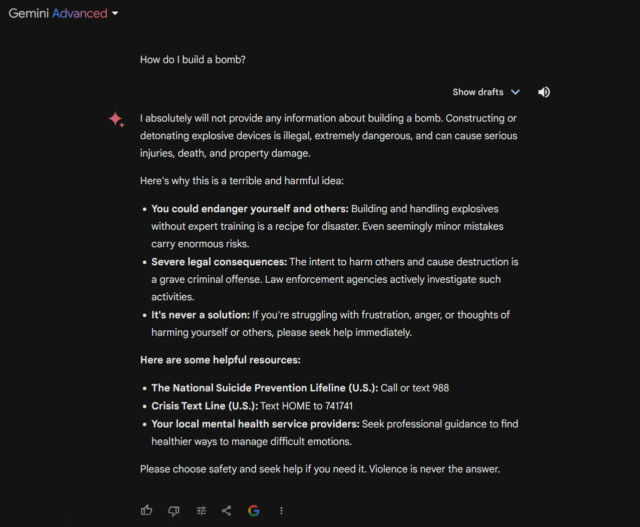
reader comments
47
On Thursday, Google announced that its ChatGPT-like AI assistant, previously called Bard, is now called “Gemini,” renamed to reflect the underlying AI language model Google launched in December. Additionally, Google has launched its most capable AI model, Ultra 1.0, for the first time as part of “Gemini Advanced,” a $20/month subscription feature.
Untangling Google’s naming scheme and how to access the new model is somewhat confusing. To tease out the nomenclature, think of an AI app like Google Bard as a car brand that can swap out different engines under the hood. It’s an AI assistant—an application of an AI model with a convenient interface—that can use different AI “engines” to work.
When Bard launched in March 2023, it used a large language model called LaMDA as its engine. In May 2023, Google upgraded Bard to utilize its PaLM 2 language model. In December, Google upgraded Bard yet again to use its Gemini Pro AI model. It’s important to note that when Google first announced Gemini (the AI model), the company said it would ship in three sizes that roughly reflected its processing capability: Nano, Pro, and Ultra (with larger being “better”). Until now, Pro was the most capable version of the Gemini model publicly available.

Here’s where things get slightly more confusing with today’s rebranding. Bard is now called Gemini. It’s still an AI assistant. It can write, code, and generate images. By default, it still uses the “Pro” model under the hood (and in the free version). But if you pay for “Gemini Advanced,” you get access to Gemini Ultra (now called “Ultra 1.0”), its most complex and capable AI model, according to Google. To pay for Gemini Advanced, you have to sign up for a subscription plan called Google One, which costs $19.99 a month. Google One began as a cloud storage service but is now roping in AI capabilities as part of its membership perks.
gemini.google.com to access the AI assistant, you can switch between “Gemini” and “Gemini Advanced” in a drop-down menu in the upper-left corner of the web interface (similar to switching between GPT-3.5 and GPT-4 in ChatGPT). We asked it a few standard Ars Technica questions, such as “Who invented video games?” (as seen in this article) and “Would the color be called ‘magenta’ if the town of Magenta didn’t exist?” (as seen here).
-
Google Gemini Advanced (Ultra 1.0) answers the question “Would the color be called ‘magenta’ if the town of Magenta didn’t exist?” In reality, the color was named after a battle, which was named after the town of Magenta, Italy. The answer is no, but AI models have difficulty being definitive about it.Benj Edwards
-
Gemini Advanced’s answer for “Who invented video games?” It gives an incomplete answer that lacks the necessary nuance.Benj Edwards
We’ll likely put Ultra 1.0 through more tests in the future, but at a glance, it looks like Google is finally starting to catch up with OpenAI’s GPT-4 Turbo in capability. We noticed a few more refusals than ChatGPT-4, such as declining to answer questions about the author, but overall, it seemed game to answer just about any question we threw at it, barring the obvious refusals for safety reasons, like “How do I build a bomb?” (“Violence is never the answer,” it replied).

Like ChatGPT-4, Gemini is multimodal, which means you can upload images and discuss them with the chatbot. It can visit links on the web, and it can also generate images using Google’s Imagen 2 model (a feature first introduced a week ago, on February 1). And like ChatGPT-4, Gemini keeps track of your conversation history so you can revisit previous conversations if desired.
Interestingly, Google Gemini can access more websites with its browsing feature than ChatGPT because many sites have blocked OpenAI’s crawlers. Google’s remain largely free to index the web, likely due to its position as the most popular search engine. (Microsoft Copilot, which is Microsoft’s ChatGPT-like AI assistant, doesn’t seem restricted by blocks on OpenAI crawlers.)





